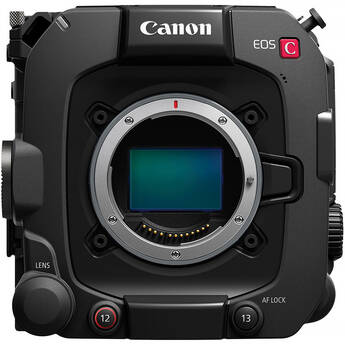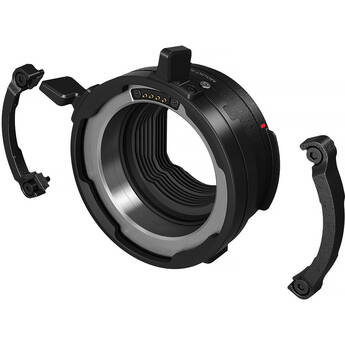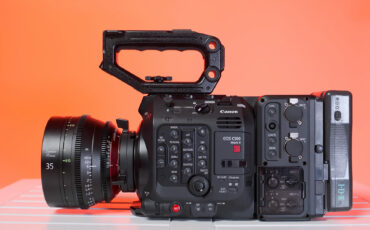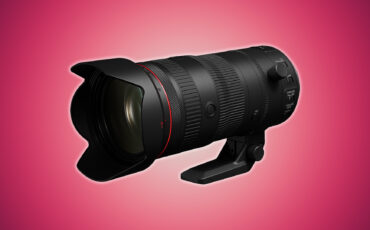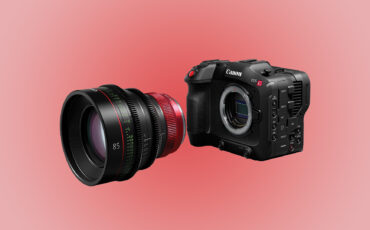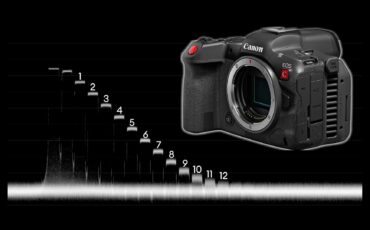Canon EOS C400 Cinema Camera Announced – 6K, Full Frame, RAW Internal Recording, Triple Base ISO, and More
Canon has just announced their latest RF-mount cinema camera: the EOS C400. This camera features a 6K Full Frame image sensor, it can record in Cinema RAW Light at up to 6K/60P onto CFexpress memory cards, it has a new 3.5″ full touchscreen LCD monitor, HDMI and SDI output ports, and much more. So, let’s take a closer look at it!
The Canon EOS C70 was announced back in September 2020, and if we omit the Canon EOS R5 C released in January 2022, this was the latest “proper” cinema camera from the company. As someone who has been using two C70s as my primary cameras for nearly four years now, there are only little things not to like about this compact beast. Canon took their time and did their homework by introducing the Canon EOS C400, a camera that corrects/improves nearly everything you could have hoped for as an EOS C70 shooter.
Canon EOS C400 – camera body
To some extent, the Canon EOS C400 can be seen as an RF-mount EOS C500 Mark II, with a box-style design compared to the DSLR/mirrorless camera style of the EOS C70. The EOS C400 measures (W x H x D) 5.6 x 5.3 x 5.3in/14,2 x 13,4 x 13,4cm for a weight of 3.5 lbs/1,58 kg. As you can tell, the EOS C400 is considerably smaller than the EOS C500 Mark II, which measures 6 x 5.8 x 6.6in/15.2 x 14.7 x 16.7cm, partially thanks to the RF lens mount. The compact body size should allow the EOS C400 to feel at home on a small gimbal such as the DJI RS 3/RS 4/RS 4 Pro.
At the front of the camera, you’ll find an RF mount with four mounting screws to firmly secure lens mount adapters via locking wings. Also, there is a built-in Mono microphone, two function buttons, and a lens power terminal that can feed power to lenses such as the Canon RF24-105mm f/2.8 L IS USM Z and its power zoom adapter
Canon R5 C Ultimate Video Manual
The top of the EOS C400 features six 1/4″-20 mounting points and a Multi-function shoe. The Multi-function shoe supplies power to external accessories directly from the camera. Some compatible accessories, such as the TASCAM CA-XLR-2d-C audio adapter and the Canon DM-E1D microphone, are compatible with the Multi-function shoe.
The camera comes with a removable top handle that is secured via three thumbscrews. Also, the top handle has a Multi-function shoe, so you can attach accessories directly to it if needed.
On the left side of the camera, you’ll find all of the control buttons that can be illuminated, the audio level dials, the CFexpress Type-B and SD card slots, and the traditional power switch with a dedicated button to switch between the camera and playback modes. You’ll feel at home with the button layout if you are a Canon EOS C500 Mark II/C300 Mark III user.
At the back of the camera, you’ll find most of the Canon EOS C400 input/output ports, including:
- One 12G-SDI and one 3G-SDI video output ports.
- A USB-C terminal.
- A 3.5mm microphone input and 3.5mm headphone output.
- Two Mini-XLR audio input ports.
- One full-size HDMI output.
- A timecode terminal and a G-Lock/Sync/RET terminal.
- A 4-pin XLR 12V DC power input.
- One remote A terminal.
As you can tell, nothing is missing. The camera is powered by new Canon BP-A30N/60N batteries. Canon mentions that you can use your current BP-A30 and BP-A60 batteries, similar to the ones used in all Canon Cinema Cameras since the EOS C200, with the new EOS C400. However, non-N batteries will not provide power to the lens terminal and multi-function shoe.
You can notice that there are four M4 screw holes at the back of the EOS C400, similar to the ones that can be found on the EOS C500 Mark II. At the moment, Canon has no accessories for these. Nonetheless, third-party accessory manufacturers can soon release V-Mount/Gold Mount battery plates and more expansion modules specifically designed for it.
Let’s finish our tour of the camera with the right side, which has two audio input switches, a full-size Ethernet port, and two USB-C grip and video terminals. Wait, a USB-C video terminal?
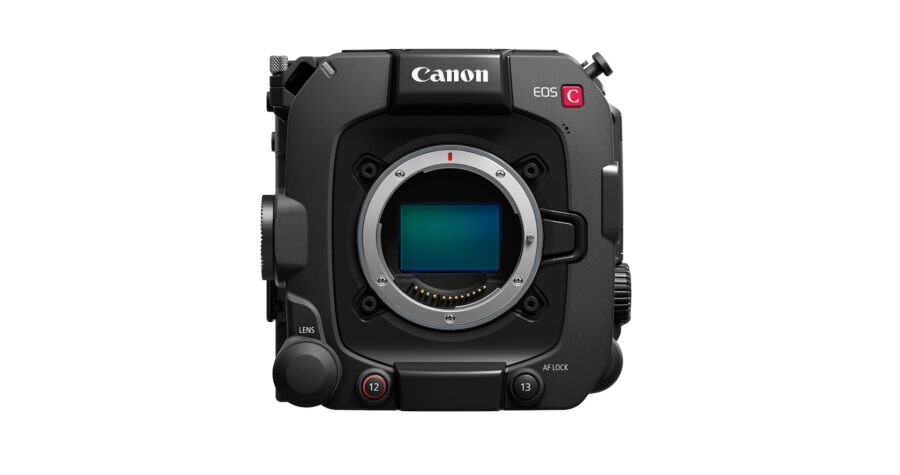
LCD monitor
The Canon EOS C400 comes with a 3.5″ full touchscreen LCD monitor. This monitor has a joystick and four function buttons to navigate inside the menu. You can navigate inside the camera menu via the LCD screen. The Quick Access sub-menu to quickly access the camera’s fundamental settings and activate monitoring tools, introduced with the Canon EOS C70, is also available on the EOS C400.
Also, the monitor comes with a new LCD attachment unit, which attaches to the camera’s top handle via a 15mm rod. This attachment unit looks like one of the most versatile Canon has ever designed. Of course, you can still attach the LCD monitor directly to your camera without the top handle, thanks to the Canon Accessory Mount anti-twist mounting system.
Something that can sound minor but that I have wished for years is the addition of a Gyro with a level display. This option quickly shows you on the screen if your camera is leveled, similar to what can be found on most DSLR/mirrorless cameras.
As I mentioned, the detachable camera grip and the LCD monitor connect to the Canon EOS C400 via USB-C ports. This is a significant change compared to the previous LANC and proprietary video connector ports. As the Canon EOS C400 doesn’t have any built-in EVF, and it has a USB-C video output port, will it be compatible with the Blackmagic Design URSA Cine EVF? During NAB 2024, Blackmagic Design told us that their EVF could be used with other cameras that can output power/video via a USB-C connector. The Canon EOS C400 can output power/video via its USB-C port, so even if we still need to get information, these two would be a fantastic combo!
A new image sensor
The Canon EOS C400 features a new 6K Full Frame back-illuminated stacked CMOS image sensor. According to Canon, it provides “the most dynamic range of any Cinema EOS Full Frame sensor.” Inside, you’ll find a DIGIC DV7 image processor, which has started to age a bit but is still very competent.
The Canon EOS C300 Mark III introduced the Dual Gain Output (DGO) sensor, which was also shared with the EOS C70. The new Canon EOS C400 doesn’t rely on that technology but uses a triple-base ISO. Here are all of the native ISO values depending on the Gamma settings:
- Canon Log 2, Canon Log 3, or RAW: base ISO of 800, 3,200, and 12,800.
- Canon 709, BT.709 Wide DR, PQ, HLG: base ISO of 400, 1,600, and 6,400.
- BT.709 standard: base ISO of 160, 640 and 2,500.
Also, every Gamma setting has an “Auto Selection” option that automatically switches to and selects the best circuit for you.
Canon EOS C400 recording formats and video codecs
The Canon EOS C400 can record internally in various codecs, including the well-known Cinema RAW Light, which provides the highest quality possible. Please note that Cinema RAW Light footage can only be recorded to a CFexpress Type-B memory card, while proxies are stored on the SD card.
For quicker turnaround projects, you still have the option to record in XF-AVC in 10-bit 4:2:2, which is one of my go-to recording codecs.
Canon also implemented two new codecs, XF-HEVC S and XF-AVC S, for smaller file sizes and proxies that use the .MP4 file format and have the same metadata/file name/folder structure as the Cinema RAW Light and XF-AVC files.
Now, let’s talk about the most essential parts: resolutions and framerates. The Canon EOS C400 can shoot internally in:
- Cinema RAW Light:
- The Canon EOS C400 can capture footage in 12-bit 6K 6000 x 3164 resolution in Full Frame sensor mode at up to 60P with a bitrate of 2130Mbps., except in RAW HQ mode, which is limited at 30P with a bitrate of 2160Mbps.
- If you change the sensor mode to Super35, the resolution drops to 4368 x 2304, and you can record at up to 60P in RAW HQ mode, and 100P in other Cinema RAW Light flavors.
- Lastly, in Super16 sensor mode, footage is captured in 2184 x 1152 at up to 180P.
- XF-AVC and XF-AVC S:
- In Intra-Frame, footage is captured in 4:2:2 10-bit in DCI 4K or 4K UHD at up to 120P. The maximum bitrate at 60P is 1200Mbps.
- Long GOP 4:2:2 10-bit in DCI 4K and 4K UHD options are also available at up to 120P.
- A Long GOP 4:2:0 8-bit proxy option is also available, with a maximum resolution of 2048 x 1080 and a maximum framerate of 180P.
- XF-HEVC S:
- 4:2:2 10-bit at up to 120P in DCI 4K and 4K UHD resolutions. If you drop down the resolution to DCI 2K or FHD, you can crank up the framerate to 180P.
- 4:2:0 10-bit at up to 120P in DCI 4K and 4K UHD resolutions. If you switch to DCI 2K/FHD, you can also reach 180P.
- 4:2:0 10-bit and 4:2:0 8-bit proxy options are also available, with a maximum resolution of 2048 x 1080 at 180P.
Please note that in 4K XF-AVC, XF-HEVC S, and XF-AVC S recording formats, in Full Frame mode, and with a frame rate of 60P or lower, the Canon EOS C400 does a 6K oversampling of the entire image sensor, which results in less moiré and an overall sharper/cleaner image.
In Cinema RAW Light, an interval recording mode is also available. You can choose the number of frames (1/3/6/9) and the interval in twelve from 1s to 10m. Lastly, there is a frame recording mode to create stop-motion animations.
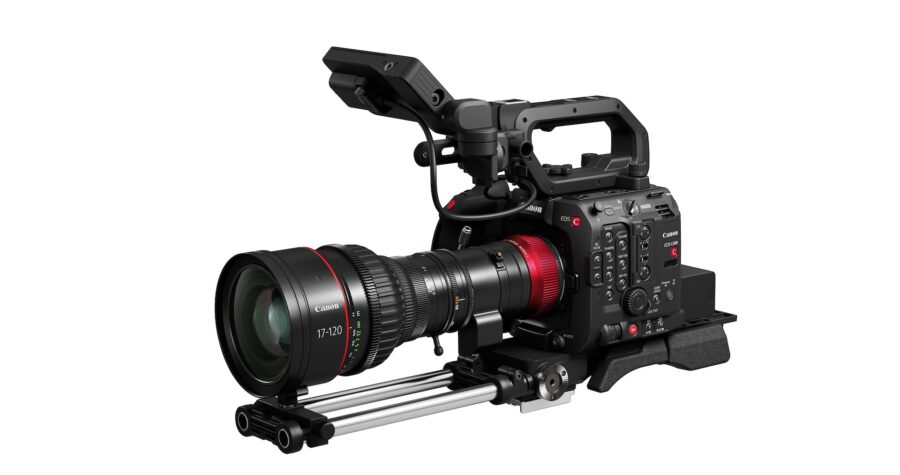
Canon EOS C400 autofocus capabilities
The Canon EOS C400 uses a new Dual Pixel CMOS AF II system that covers 100% of the frame. The camera can detect people and animals. For people, the EOS C400 can recognize eyes, faces, heads, and bodies. Also, new autofocus frame size options are available, including small zone, square zone, large zone vertical, and large zone horizontal.
Last but not least, “Face Priority” and “Face Only” options have been replaced with “Detection Priority” and “Detection Only”.
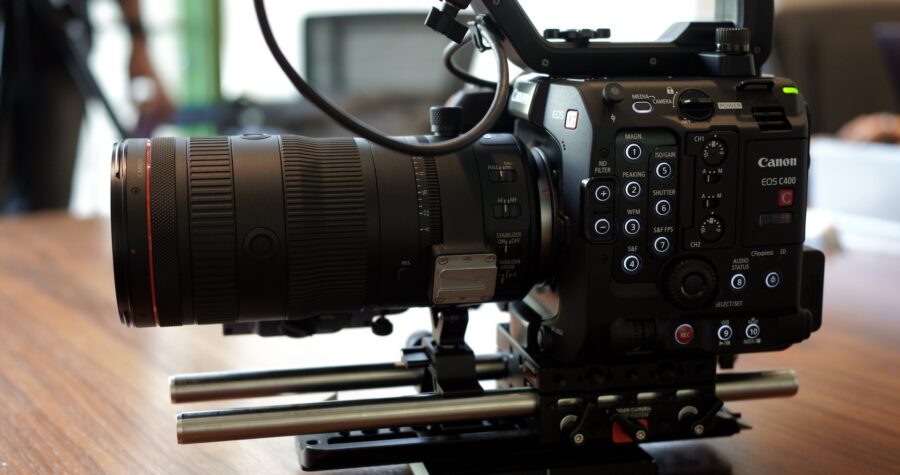
Audio features
As mentioned, the EOS C400 has two Mini-XLR and one 3.5mm jack audio input. In total, the camera can record four 24-bit linear PCM audio tracks. You can use the TASCAM CA-XLR-2d-C audio adapter on the Multi-function shoe to have two extra full-size XLR ports, but you’re still limited to four audio tracks.
Canon made one minor but much-welcome improvement: the audio level meters are now in color, making adjusting audio levels easier.
ND Filters, Digital IS, and anamorphic lens support
The Canon EOS C400 has built-in ND filters that can go from 0 to 6 stops in normal mode and up to 10 stops in extension mode. You can now set the ND display units in stops, transmittance, or optical density, which is very handy.
If you shoot with anamorphic lenses, you can de-squeeze the image with three settings: 2x, 1.8x, and 1.3x. I would’ve liked to see a user-customizable de-squeeze option or more de-squeeze options, such as 1.5x, but it might come in a future firmware update. The de-squeezed image can be viewed on the LCD monitor but can also be output to the Mon./HDMI ports.
Unfortunately, the EOS C400 doesn’t have in-body image stabilization (IBIS), but only a Digital IS. If your lens has image stabilization, you can use Digital IS in combination with the lens’s optical image stabilization for better results. Furthermore, Canon introduced a new “Motion Vector for Digital IS” setting that tells the Digital IS to ignore subject movement in the frame to avoid unwanted correction artifacts. I rarely use Digital IS as post-production stabilization usually gives me better and more controlled results.
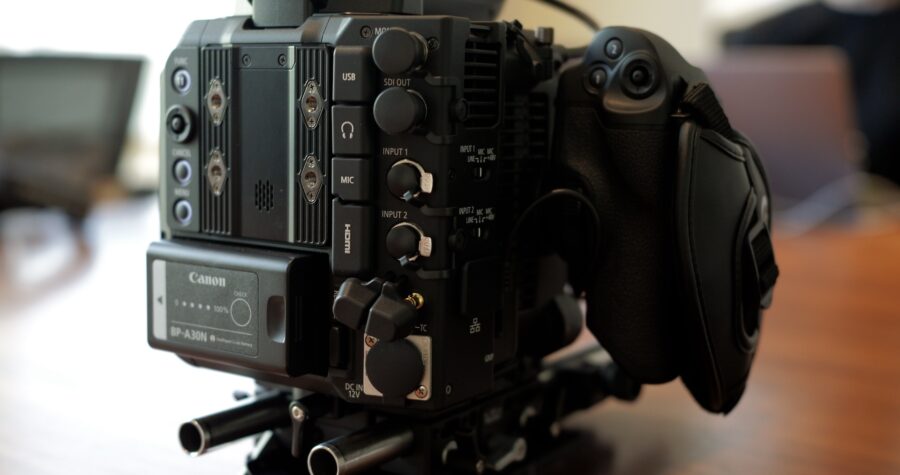
Connectivity
In terms of wired/wireless connectivity, the EOS C400 gives you multiple options:
- You can connect the camera to the RC-IP1000/RC-IP100 remote controllers via an Ethernet cable.
- Using the Remote Camera Controller app, you can control up to 20 cameras on a computer using the XC protocol via an Ethernet cable or Wi-Fi.
- The Canon Multi-Camera Control smartphone app allows you to connect up to four cameras for camera control wirelessly.
- Last but not least, you can use the Browser Remote app wired or wirelessly to control a single camera.
Lastly, the EOS C400 supports Unreal Engine and Adobe After Effects virtual production workflows for real-time or CG compositing via Canon plugins.
Price and availability
The Canon EOS C400 will be available in September 2024 for $7,999. The camera ships with:
- The top handle.
- LCD monitor, monitor cable, and attachment unit.
- Microphone holder and screws.
- The camera grip.
- One Canon BP-A60N battery, a CG-A20 battery charger, and the CA-CP300B power adapter.
- A tape measure, hook, and wrench.
For more information, please visit Canon’s website here.
What do you think about this new Canon Cinema Camera? Do you consider upgrading from the Canon EOS C70, C300 Mark III, or C500 Mark II to this new model? What feature do you wish the EOS C400 had? Don’t hesitate to let us know in the comments down below!
